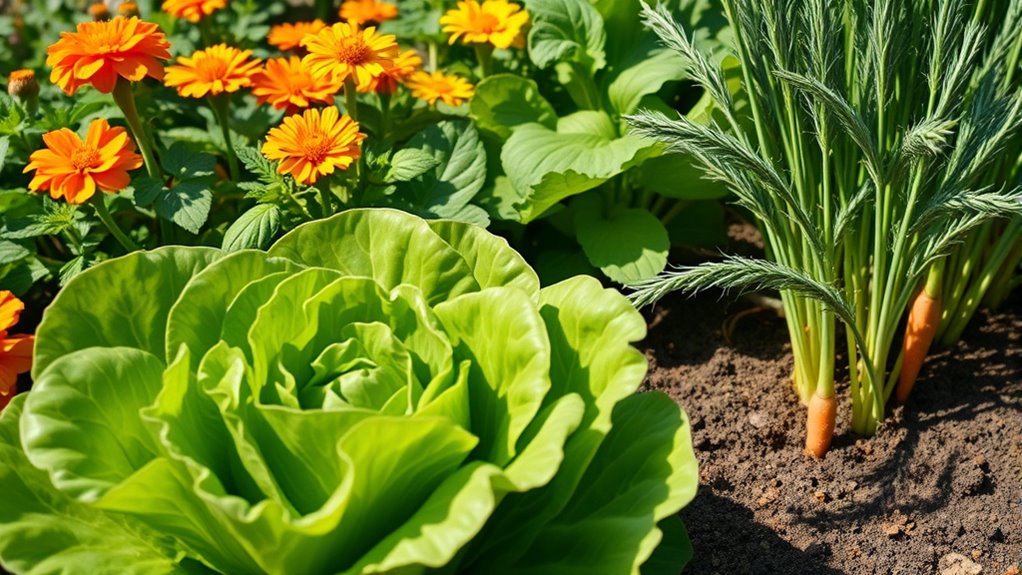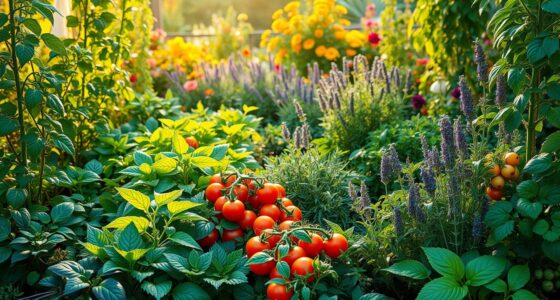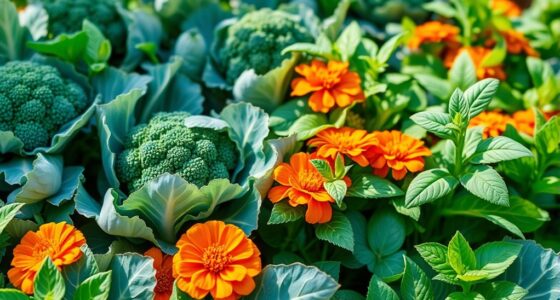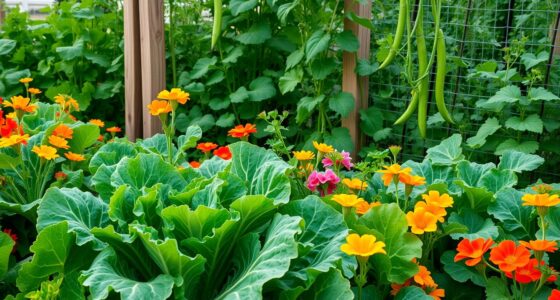For the best companion plants for lettuce, consider herbs like basil, chives, and dill, which repel pests and improve flavor. Veggies like carrots and radishes help with soil and free up space, while vegetables such as cucumbers provide shade. Bright flowers like marigolds and daisies attract beneficial insects that control pests naturally. Avoid plants like onions and broccoli nearby, as they can hinder lettuce growth. Keep these tips in mind to create a thriving garden—there’s more to discover next.
Key Takeaways
- Herbs like basil, chives, and dill repel pests and improve lettuce flavor.
- Carrots, radishes, and spinach enhance soil conditions and maximize garden space for lettuce.
- Marigolds, daisies, and calendula attract beneficial insects that control pests.
- Avoid planting alliums, brassicas, and fennel nearby to prevent pest attraction and growth inhibition.
- Group compatible plants, ensure good airflow, and use taller plants for shade to optimize lettuce growth.
Herbs That Complement Lettuce
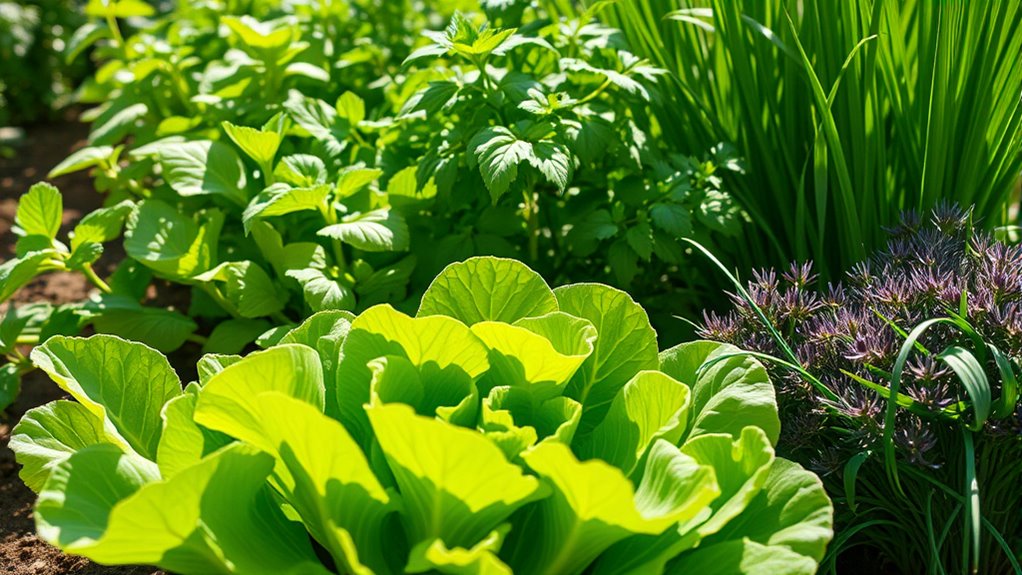
Herbs can be a great addition to your lettuce garden because they not only enhance flavor but also support healthy growth. Basil, chives, and dill are excellent choices that naturally repel pests like aphids and slugs, protecting your lettuce. Basil’s fragrant leaves deter insects and improve the taste of nearby greens. Chives emit a sulfur scent that keeps away aphids and spider mites while attracting beneficial insects. Dill, with its feathery foliage, repels pests and attracts pollinators, boosting overall garden health. These herbs also grow quickly and can be harvested regularly, providing fresh flavor for your kitchen. Planting them near your lettuce offers a natural, sustainable way to maintain a pest-free, thriving garden without relying on chemicals.
Vegetables That Enhance Lettuce Growth
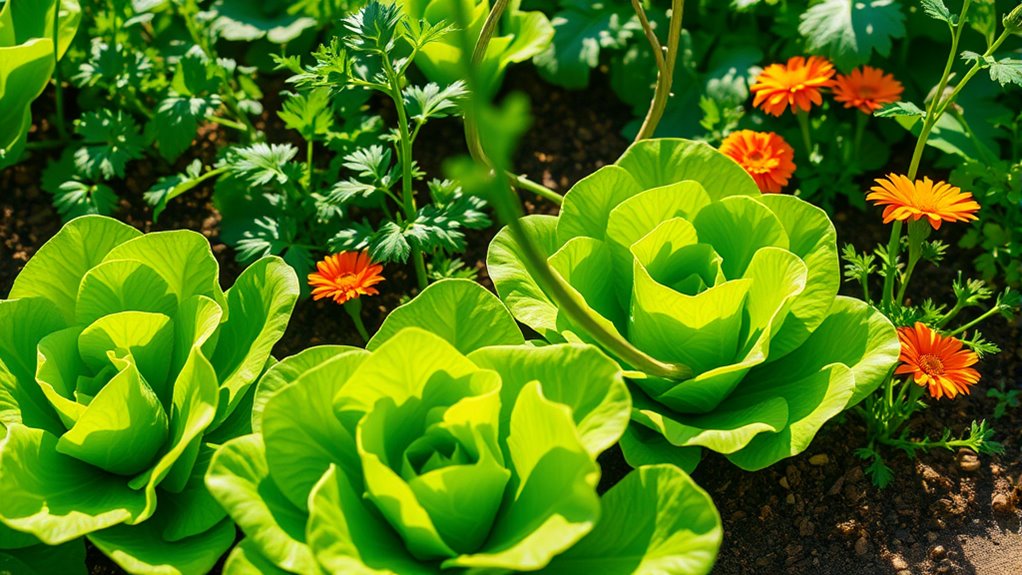
Planting certain vegetables alongside lettuce can naturally boost its growth and resilience. For example, carrots help loosen the soil, improving drainage and root access for lettuce. Radishes mature quickly and can be harvested early, making room for lettuce to expand. Spinach shares similar growth habits and can be planted nearby to maximize space. Cucumbers or summer squash, when grown vertically, provide shade that keeps lettuce cool and reduces bolting in hot weather. Additionally, beets enrich the soil with nutrients as they grow, benefiting the lettuce roots. These vegetables not only promote healthier lettuce but also improve overall garden productivity. By choosing these companions, you create a balanced, mutually beneficial environment that supports robust lettuce growth throughout the season.
Flowers That Attract Beneficial Insects
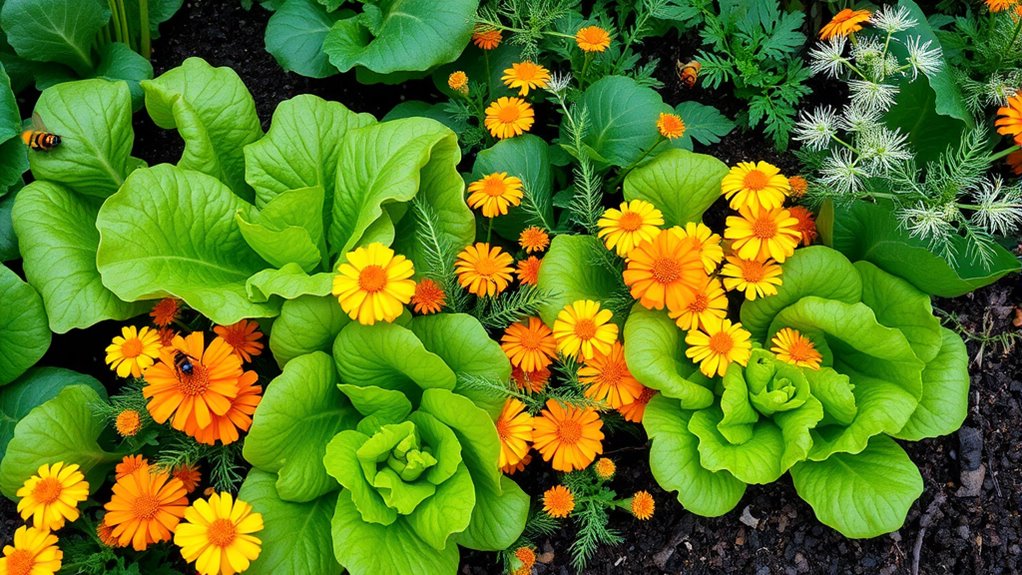
Flowers that attract beneficial insects can considerably improve your lettuce garden’s health. By planting blooms like calendula, marigolds, and daisies, you draw in pollinators and natural predators such as ladybugs and parasitic wasps. These insects help control common lettuce pests like aphids and whiteflies naturally, reducing your need for chemical interventions. Choose flowers with bright colors and nectar-rich blooms, as they are especially attractive to beneficial insects. Regularly deadhead spent flowers to keep attracting new visitors. Incorporate a variety of flowering plants to ensure a continuous supply of nectar and pollen throughout the growing season. Doing so creates a balanced ecosystem, promoting healthy lettuce growth while minimizing pest problems. Utilize natural materials for garden supports and decor to further enhance the habitat for beneficial insects. Additionally, planting flowers associated with IPM strategies can help reinforce natural pest control methods in your garden. Incorporating companion planting techniques can further increase the effectiveness of attracting beneficial insects and protecting your lettuce crop. Introducing diverse flowering plants can also extend the period of beneficial insect activity, supporting a healthier garden environment. Moreover, selecting flowers that are native to your region can improve their attractiveness and resilience, ensuring sustained insect activity.
Plants to Avoid Growing Near Lettuce
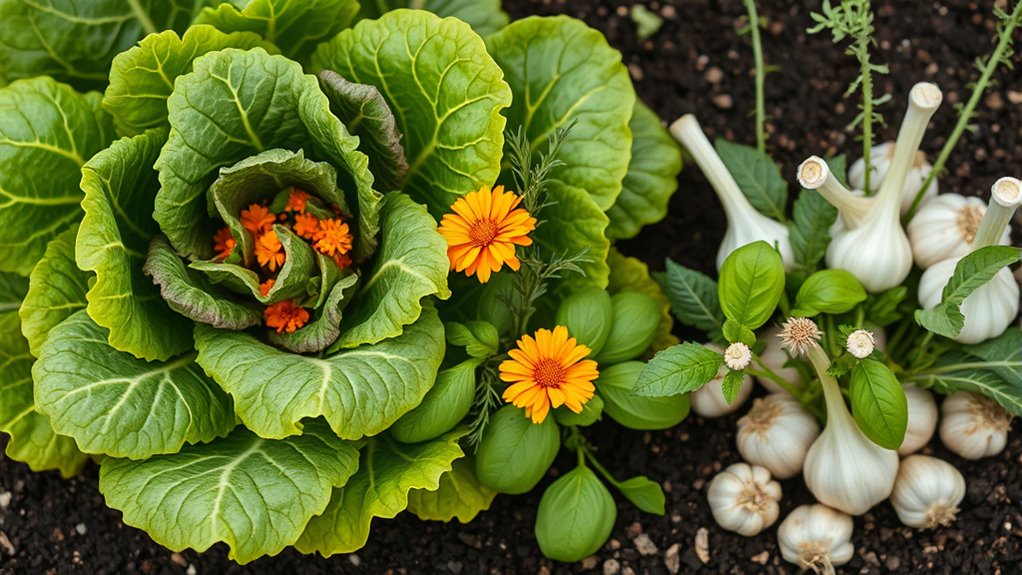
While it might be tempting to grow a variety of plants near your lettuce, certain species can hinder its growth or attract pests. Avoid planting members of the allium family, like onions and garlic, close to lettuce, as they can stunt its development. Also, steer clear of brassicas such as cabbage and broccoli, which can compete for nutrients and space. Nasturtiums, although beneficial when kept at a distance, may attract aphids that could spread to your lettuce. Additionally, avoid planting fennel nearby, as it tends to inhibit the growth of many vegetables, including lettuce. Keep these plants separate to prevent issues like pest attraction or nutrient competition, ensuring your lettuce remains healthy and productive. Understanding plant relationships can help optimize your garden’s health and yield, especially by considering how plant compatibility impacts growth.
Tips for Designing a Successful Companion Planting Scheme
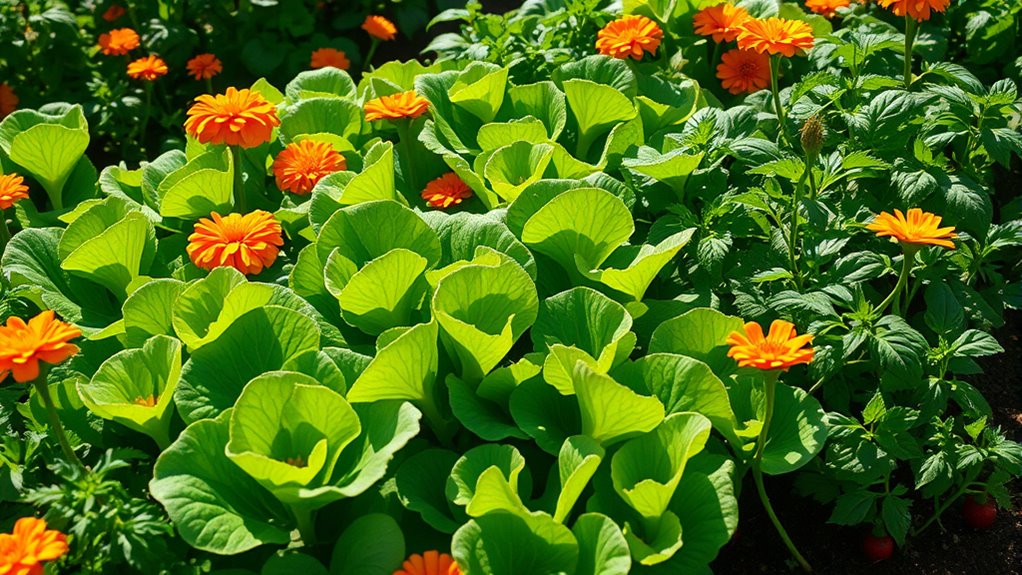
Designing a successful companion planting scheme starts with understanding how different plants interact and support each other. Begin by grouping plants with complementary traits, such as those that repel pests or improve soil nutrients. Plan your layout to maximize airflow and sun exposure, reducing disease risk. Mix fast-growing plants like lettuce with slower ones to optimize space. Use taller plants to provide shade for lettuce during hot weather. Keep in mind plant spacing to avoid overcrowding, which can hinder growth. Incorporate herbs like dill or basil near lettuce to attract beneficial insects and deter pests. Finally, rotate your plantings each season to prevent soil depletion and reduce disease buildup. With thoughtful planning, your garden can thrive with healthy, productive companion relationships.
Frequently Asked Questions
How Does Soil Ph Influence Companion Planting With Lettuce?
Soil pH plays a vital role in your lettuce’s growth and how well it interacts with companion plants. If the soil’s too acidic or alkaline, it can hinder nutrient absorption, affecting both lettuce and its neighbors. You should aim for a pH between 6.0 and 7.0 for ideal growth. By maintaining proper pH, you guarantee healthy plants and better interactions with your chosen companions, boosting your garden’s productivity.
Can Companion Plants Extend Lettuce’S Growing Season?
Companion plants can definitely help extend your lettuce’s growing season. By planting crops that provide shade or help retain soil moisture, you create a microclimate that protects lettuce from harsh weather. These plants can also deter pests and improve soil health, allowing you to grow lettuce longer. With the right companions, you’ll enjoy fresh greens well into the cooler months, maximizing your garden’s productivity.
Are There Any Common Pests Deterred by Specific Companion Plants?
Did you know that planting certain companions can reduce pest damage by up to 50%? You can deter common pests like aphids, slugs, and whiteflies by adding plants such as marigolds, aromatic herbs, or nasturtiums nearby. These companions release natural repellents and attract beneficial insects that prey on pests, helping you protect your lettuce without pesticides. Incorporating these plants creates a healthier, more resilient garden environment.
How Much Space Should Be Left Between Lettuce and Its Companions?
You should leave about 8 to 12 inches of space between your lettuce and its companion plants. This spacing guarantees good air circulation, which helps prevent diseases and allows each plant to access nutrients and sunlight effectively. If you’re planting taller companions, give them even more room to avoid shading your lettuce. Proper spacing promotes healthy growth and makes maintenance easier, so your garden stays productive and pest-free.
Do Companion Plants Impact Lettuce Flavor or Nutritional Value?
Flavor and nutrition flourish when friendly companion plants foster a healthy habitat. You might notice that certain plants, like herbs or marigolds, can subtly boost lettuce’s taste and nutritional value by repelling pests or enriching soil. While some companions enhance flavor and nutrition through their own properties, others simply support overall plant health. So, yes, your choice of companions can positively impact the flavor and nourishment of your lettuce.
Conclusion
So, go ahead and plant those perfect companions for your lettuce—just watch out for the sneaky plants that might outsmart your garden plans. It’s almost ironic how some neighbors can be your garden’s best friends or worst enemies. With a little planning, you’ll create a thriving, harmonious space where your lettuce can flourish—unless, of course, the weeds decide to throw a surprise party. Happy gardening, and may your plants always play nice!
